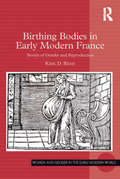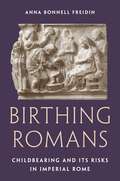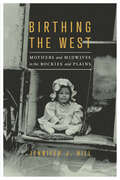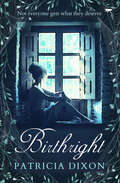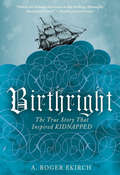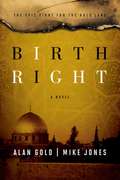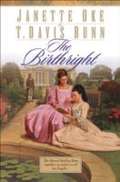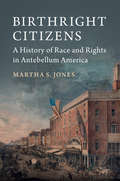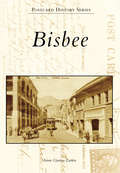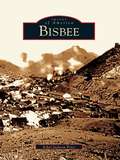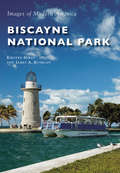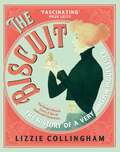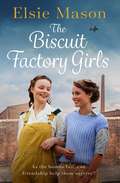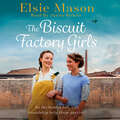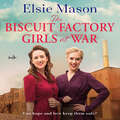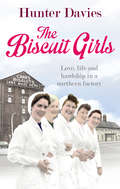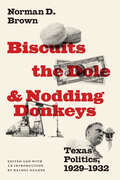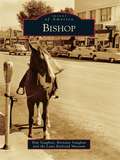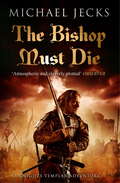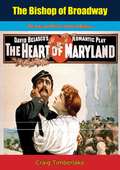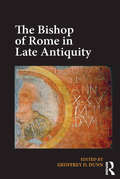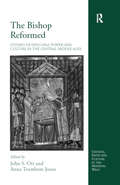- Table View
- List View
The Birthday Party: a beautifully evocative and enthralling trip down memory lane from multi-million copy seller Elvi Rhodes…
by Elvi RhodesAn emotional story of recollections and reminiscences, The Birthday Party sees multi-million copy seller Elvi Rhodes at her heart-warming best. Fans of Rosamunde Pilcher, Maeve Binchy and Erica James will not be disappointed.Readers are loving THE BIRTHDAY PARTY!'I just couldn't put this book down' -- ***** Reader review'Keeps you interested right up to the very last word' -- ***** Reader review'Wonderful' -- ***** Reader review**************************************************************************************************A LANDMARK BIRTHDAY BRINGS BACK MEMORIES - SOME HAPPIER THAN OTHERSPoppy's family is gathering to celebrate her eightieth birthday. Her children, grandchildren and even one great-grandchild are converging on her Sussex home.As she prepares to welcome them all, her mind goes back over her life - to her tough childhood in Yorkshire; to her mother - who scrimped and saved to bring her up decently; to her three husbands and to Alun, the great love of her life who was taken from her by the war.Yes, she has had a full life - a lot fuller than her family realises.As they toast their beloved matriarch, little do they know what an extraordinary and often shocking life she has led...
Birthing Bodies in Early Modern France: Stories of Gender and Reproduction (Women And Gender In The Early Modern World Ser.)
by Kirk D. ReadThe pregnant, birthing, and nurturing body is a recurring topos in early modern French literature. Such bodies, often metaphors for issues and anxieties obtaining to the gendered control of social and political institutions, acquired much of their descriptive power from contemporaneous medical and scientific discourse. In this study, Kirk Read brings together literary and medical texts that represent a range of views, from lyric poets, satirists and polemicists, to midwives and surgeons, all of whom explore the popular sixteenth- and early seventeenth-century narratives of birth in France. Although the rhetoric of birthing was widely used, strategies and negotiations depended upon sex and gender; this study considers the male, female, and hermaphroditic experience, offering both an analysis of women's experiences to be sure, but also opening onto the perspectives of non-female birthers and their place in the social and political climate of early modern France. The writers explored include Rabelais, Madeleine and Catherine Des Roches, Louise Boursier, Pierre de Ronsard, Pierre Boaistuau and Jacques Duval. Read also explores the implications of the metaphorical use of reproduction, such as the presentation of literary work as offspring and the poet/mentor relationship as that of a suckling child. Foregrounded in the study are the questions of what it means for women to embrace biological and literary reproduction and how male appropriation of the birthing body influences the mission of creating new literary traditions. Furthermore, by exploring the cases of indeterminate birthing entities and the social anxiety that informs them, Read complicates the binarisms at work in the vexed terrain of sexuality, sex, and gender in this period. Ultimately, Read considers how the narrative of birth produces historical conceptions of identity, authority, and gender.
Birthing Romans: Childbearing and Its Risks in Imperial Rome
by Anna Bonnell FreidinHow Romans coped with the anxieties and risks of childbirthAcross the vast expanse of the Roman Empire, anxieties about childbirth tied individuals to one another, to the highest levels of imperial politics, even to the movements of the stars. Birthing Romans sheds critical light on the diverse ways pregnancy and childbirth were understood, experienced, and managed in ancient Rome during the first three centuries of the Common Era.In this beautifully written book, Anna Bonnell Freidin asks how inhabitants of the Roman Empire—especially women and girls—understood their bodies and constructed communities of care to mitigate and make sense of the risks of pregnancy and childbirth. Drawing on medical texts, legal documents, poetry, amulets, funerary art, and more, she shows how these communities were deeply human yet never just human. Freidin demonstrates how patients and caregivers took their place alongside divine and material agencies to guard against the risks inherent to childbearing. She vividly illustrates how these efforts and vital networks offer a new window onto Romans&’ anxieties about order, hierarchy, and the individual&’s place in the empire and cosmos.Unearthing a risky world that is both familiar and not our own, Birthing Romans reveals how mistakes, misfortunes, and interventions in childbearing were seen to have far-reaching consequences, reverberating across generations and altering the course of people&’s lives, their family histories, and even the fate of an empire.
Birthing the West: Mothers and Midwives in the Rockies and Plains
by Jennifer J. HillChildbirth defines families, communities, and nations. In Birthing the West, Jennifer J. Hill fills the silences around historical reproduction with copious new evidence and an enticing narrative, describing a process of settlement in the American West that depended on the nurturing connections of reproductive caregivers and the authority of mothers over birth. Economic and cultural development depended on childbirth. Hill&’s expanded vision suggests that the mantra of cattle drives and military campaigns leaves out essential events and falls far short of an accurate representation of American expansion. The picture that emerges in Birthing the West presents a more complete understanding of the American West: no less moving or engaging than the typical stories of extraction and exploration but concurrently intriguing and complex.Birthing the West unearths the woman-centric practice of childbirth across Montana, the Dakotas, and Wyoming, a region known as a death zone for pregnant women and their infants. As public health entities struggled to establish authority over its isolated inhabitants, they collaborated with physicians, eroding the power and control of mothers and midwives. The transition from home to hospital and from midwife to doctor created a dramatic shift in the intimately personal act of birth.
Birthright
by Patricia DixonA woman&’s quest to save her family&’s chateau in France brings danger, rivalry, and romance—and reveals a secret buried since World War II . . . 1931, Chateau de Chevalier: Ophélie, La Duchesse de Bombelle, receives a love letter from her admirer Picasso along with a gift: a priceless painting. Nine years later, the Nazis invade France and steal countless works of art, including Ophélie&’s gift . . . Present day: Ophélie&’s grandson, Hugo, has run the family finances into the ground, and the Chateau is in danger of being sold. Fabienne, heiress to the estate, has hastily returned from London and is desperate to save her home. Meanwhile, Mac, a British man who has spent every summer in France with his late grandparents, inherits their cottage—but his property is in danger of being lost as well. When Mac returns, memories of happy times with two people he adored come flooding back—along with guilt that he didn&’t return in time to say goodbye to his beloved grandfather. When Mac is reunited with Fabienne, their attempts to rescue their futures will plunge them into the darkness of the past—and the dangers of the present—in this powerful, suspenseful saga by the author of Resistance.
Birthright: The True Story that Inspired Kidnapped
by A. Roger Ekirch"Ekirch out-kidnaps Stevenson in this thrilling, thoroughly documented story." --Booklist, starred review No saga of personal hardship so captivated the British public in the eighteenth century as that of James Annesley, the presumptive heir of five aristocratic titles and scion of the mighty house of Annesley. Kidnapped at twelve years of age by his uncle and sold into indentured servitude in America, James would ultimately escape after toiling for twelve years in Delaware, returning to Ireland to bring his blood rival, the Earl of Anglesea, to justice in one of the epic trials of the century. Set against the volatile backdrop of Georgian Ireland, historian A. Roger Ekirch recounts the extraordinary family drama that inspired Robert Louis Stevenson's classic novel Kidnapped "with dash and clarity" (Kirkus Reviews).
Birthright
by Alan Gold Mike JonesThe dramatic fight for modern Jewish statehood forms the backdrop of this second book in the Heritage trilogy, a series of epic political thrillers set in Jerusalem.Following Bloodline, in which Bilal and Yael raced to thwart a terrorist plot in modern-day Jerusalem, Book Two travels six decades into the past and introduces Yael's grandparents: Shalman, a freedom fighter turned peacenik archaeologist, and his young, beautiful wife Judit, a refugee from the horrors of Stalin's USSR. As WWII draws to a close and the truth about Hitler's genocide emerges, the need for a permanent safe haven for the Jewish people takes on unprecedented urgency. But the path to statehood is anything but clear. Throughout Palestine, Arab and Jewish forces battle each other and the British for supremacy in a nightmarish environment riddled with hatred and suspicion. A plot to fashion the fledgling Israeli nation as a puppet of the Soviet Union--undermining Israel's future as an independent nation--rests upon a handful of committed Jewish Communists, led covertly by Judit. Meanwhile, in a parallel storyline going back to the darkest recesses of ancient history, Shalman's ancestors flee the grisly Roman occupation of Jerusalem, witness the glories of the Islamic renaissance in Baghdad, and endure the rampages of the Crusaders. Set in one of the most fraught regions in the world and spanning centuries, this pulse-pounding, timely thriller centers on a turning point in the inexorable conflict that still rages today.
The Birthright (Song of Acadia #3)
by Janette Oke T. Davis BunnThe Thread Binding Them Together As Sisters Is All Too Fragile...<P><P> The bittersweet reunion of the Robichaud family and the Harrows in the land of the Acadians has brought two mothers and two daughters full circle. They rekindle those early bonds and experience restoration of those lost years, but time and tragedy have left their indelible imprints on all who have endured the decades of separation and uncertainty. Moving forward with their lives now means further farewells--not as devastating as the one long ago, but no less heart wrenching.<P> Their connection, which goes beyond that of "sisters" to best friends, will be tested by the coming Revolution and the lure of England--parted again, the reunited, but for how long...? Can their friendship sustain the startling revelation concerning...The Birthright?
Birthright Citizens: A History of Race and Rights in Antebellum America (Studies in Legal History)
by Martha S. JonesBefore the Civil War, colonization schemes and black laws threatened to deport former slaves born in the United States. Birthright Citizens recovers the story of how African American activists remade national belonging through battles in legislatures, conventions, and courthouses. They faced formidable opposition, most notoriously from the US Supreme Court decision in Dred Scott. Still, Martha S. Jones explains, no single case defined their status. Former slaves studied law, secured allies, and conducted themselves like citizens, establishing their status through local, everyday claims. All along they argued that birth guaranteed their rights. With fresh archival sources and an ambitious reframing of constitutional law-making before the Civil War, Jones shows how the Fourteenth Amendment constitutionalized the birthright principle, and black Americans' aspirations were realized. Birthright Citizens tells how African American activists radically transformed the terms of citizenship for all Americans.
Bisbee
by Annie Graeme LarkinVisually, the Bisbee of today remains a community frozen in time, with Main Street retaining its character from 1910. The discovery of copper deposits in the Mule Mountains brought forth a wealth that enabled a substantial community. Profitable mining ventures and a need for labor drew thousands of miners from around the world to work in Bisbee. These individuals added a distinct flavor to the area. Like countless other Western mining camps, Bisbee evolved from a rough frontier community surviving disastrous fires and floods into a town with a substantial population and solid foundation. Bisbee's seemingly inexhaustible mineral wealth resulted in the community becoming a center of economic and political power in an emerging territory on its way to statehood. It was Arizona's greatest copper camp.
Bisbee
by Ethel Jackson PriceIn the early 1900s, it was the largest city between St. Louis and San Francisco, bustling with the raw material of Wild West legends. Bisbee's infamous Brewery Gulch once supported 47 saloons and was considered the "liveliest spot between El Paso and San Francisco." By the 1970s, opportunists had relieved Bisbee's Mule Mountains of billions of pounds of copper, 102 million ounces of silver, 2.8 million ounces of gold, and millions of pounds of zinc, lead, and manganese. The ore reserves were depleted, and when the last pickaxe struck plain old dirt, a mass exodus of miners collapsed the real estate market. But the lure of cheap land was a magnet for retirees, hippies, and artists. Boarding houses were converted into charming bed and breakfasts. Antique stores, galleries, cafes, and restaurants replaced the saloons. These days, a vibrant and eclectic community of ranchers, politicians, and free spirits; a well-preserved architectural and historic heritage; and "the most perfect year-round climate" make Bisbee, the county seat, a one-of-a-kind gem.
Biscayne National Park (Images of Modern America)
by James A. Kushlan Kirsten HinesBiscayne National Park protects the larger portion of south Florida�s Biscayne Bay, a uniquely tropical lagoon harboring crocodiles, manatees, dolphins, and Caribbean fish. Tropical trees cover its islands, while the world�s fourth-longest coral reef sits offshore. Native Americans lived here thousands of years ago; the Spanish held it for 200 years. Hundreds of ships foundered on the reef, fueling a lucrative wrecking industry. In the late 1800s, hardy homesteaders created an agricultural and fishing community. In the 1920s and 1930s, it became a playground for the newly rich and famous. Bracketed by Miami and Key Biscayne to the north and Key Largo to the south, the nearby population eventually grew to over 2.5 million residents and over 14 million annual visitors. To protect these unique natural and historical resources and to assure its enjoyment by future generations, a half century ago, the federal government created Biscayne National Monument, which later became Biscayne National Park.
The Biscuit: The History of a Very British Indulgence
by Lizzie CollinghamBourbons. Custard Creams. Rich Tea. Jammie Dodgers. Chocolate Digestives. Shortbread. Ginger snaps. Which is your favourite? British people eat more biscuits than any other nation; they are as embedded in our culture as fish and chips or the Sunday roast. We follow the humble biscuit's transformation from durable staple for sailors, explorers and colonists to sweet luxury for the middling classes to comfort food for an entire nation. Like an assorted tin of biscuits, this charming and beautifully illustrated book has something to offer for everyone, combining recipes for hardtack and macaroons, Shrewsbury biscuits and Garibaldis, with entertaining and eye-opening vignettes of social history.
The Biscuit Factory Girls: A heartwarming saga about war, family and friendship to cosy up with this spring
by Elsie MasonCan Irene find a new home by the docks?Newly married to dashing RAF officer, Tom, Irene Farley leaves behind her safe countryside life to move in with his family by the docks in South Shields. Little prepares her for the devastation the Jerry bombers have wreaked on the Sixteen Streets or that they would be living under her mother-in-law's roof, alongside Tom's three brothers and two wives!Irene's only escape is her job at the local Wright's Biscuit factory packing up a little taste of home for the brave boys fighting for King and country across the channel. As the threat of war creeps ever closer to the Sixteen Streets, the biscuit factory girls bond together, because no one can get through this war alone...
The Biscuit Factory Girls: A heartwarming saga about war, family and the importance of friendship
by Elsie MasonCan Irene find a new home by the docks?Newly married to dashing RAF officer, Tom, Irene Farley leaves behind her safe countryside life to move in with his family by the docks in South Shields. Little prepares her for the devastation the Jerry bombers have wreaked on the Sixteen Streets or that they would be living under her mother-in-law's roof, alongside Tom's three brothers and two wives!Irene's only escape is her job at the local Wright's Biscuit factory packing up a little taste of home for the brave boys fighting for King and country across the channel. As the threat of war creeps ever closer to the Sixteen Streets, the biscuit factory girls bond together, because no one can get through this war alone...
The Biscuit Factory Girls at War: A new uplifting saga about war, family and friendship to warm your heart this spring
by Elsie MasonHome is where the heart is...Beryl was the first Farley clan bride, finding a home in the arms of loving, attentive, elder son Tony. Yet even now, wrapped in Tony's embrace, Beryl has never quite been able to forget the past she ran away from, nor the shocking family secret she tried to bury. With Tony away fighting the Jerries alongside his brothers, it's up to Beryl and her sisters-in-law to keep the family afloat. Hard, gruelling work doesn't faze her, but the sudden arrival of a devastating letter does... Will Beryl be able to hold her family together and face up to her past? Or will the war take away the one thing she holds most dear - the one person she never thought she deserved?The perfect family saga, set on the Newcastle streets that inspired Catherine Cookson's bestselling classic The Fifteen Streets - This is the second in brand new series for fans of Nancy Revell, Elaine Everest and Daisy Styles.* * * * * * *Readers are LOVING the first Biscuit Factory Girls saga..."Could not put it down" 5*"A brilliant story from a brilliant author" 5*"I enjoyed every bit of this book" 5*"The end had me in tears" 5*"Stays with you long after you've turned the last page" 5*
The Biscuit Girls
by Hunter DaviesIvy, Dulcie, Barbara, Ann, Dorothy and Jean all had different reasons for applying to work at Carr’s biscuits, but once they had put on their overalls and walked through the factory gates they discovered a community full of life, laughter and friendship. To those who didn’t know, the biscuit factory that towered over Carlisle might look like just another slice of the industrial North, a noisy and chaotic place with workers trooping in and out at all hours. For the biscuit girls it was a place where they worked hard, but also where they gossiped, got into scrapes and made lifelong friends. Outside the factory walls there might be difficult husbands or demanding kids, and sometimes even heartbreak and tragedy, but they knew there would always be an escape from their troubles at Carr's. Some, like Barbara, only applied because she needed the extra cash, until things got a bit easier at home. Her supervisor cross examined her about who would be looking after the kids while she was at work, but let her have the job. Like many of the women who joined up ‘temporary’ Barbara went on to stay at Carrs for 32 years.Beginning in the 1940s, these heartwarming and vividly-remembered stories have all been told by the women themselves to Hunter Davies.
Biscuits, the Dole, and Nodding Donkeys: Texas Politics, 1929–1932
by Norman D. BrownWhen the venerable historian Norman D. Brown published Hood, Bonnet, and Little Brown Jug in 1984, he earned national acclaim for revealing the audacious tactics at play in Texas politics during the Roaring Twenties, detailing the effects of the Ku Klux Klan, newly enfranchised women, and Prohibition. Shortly before his death in 2015, Brown completed Biscuits, the Dole, and Nodding Donkeys, which picks up just as the Democratic Party was poised for a bruising fight in the 1930 primary. Charting the governorships of Dan Moody, Ross Sterling, Miriam “Ma” Ferguson in her second term, and James V. Allred, this engrossing sequel takes its title from the notion that Texas politicians should give voters what they want (“When you cease to deliver the biscuits they will not be for you any longer,” said Jim “Pa” Ferguson) while remaining wary of federal assistance (the dole) in a state where the economy is fueled by oil pump jacks (nodding donkeys).Taking readers to an era when a self-serving group of Texas politicians operated in a system that was closed to anyone outside the state’s white, wealthy echelons, Brown unearths a riveting, little-known history whose impact continues to ripple at the capitol.
Biscuits, the Dole, and Nodding Donkeys: Texas Politics, 1929–1932
by Norman D. Brown&“A fascinating tour of Texas state politics during the Great Depression&” from the historian and author of Hood, Bonnet, and Little Brown Jug (Keith J. Volanto, author of Texas Voices). When the venerable historian Norman D. Brown published Hood, Bonnet, and Little Brown Jug in 1984, he earned national acclaim for revealing the audacious tactics at play in Texas politics during the Roaring Twenties, detailing the effects of the Ku Klux Klan, newly enfranchised women, and Prohibition. Shortly before his death in 2015, Brown completed Biscuits, the Dole, and Nodding Donkeys, which picks up just as the Democratic Party was poised for a bruising fight in the 1930 primary. Charting the governorships of Dan Moody, Ross Sterling, Miriam &“Ma&” Ferguson in her second term, and James V. Allred, this engrossing sequel takes its title from the notion that Texas politicians should give voters what they want (&“When you cease to deliver the biscuits they will not be for you any longer,&” said Jim &“Pa&” Ferguson) while remaining wary of federal assistance (the dole) in a state where the economy is fueled by oil pumpjacks (nodding donkeys). Taking readers to an era when a self-serving group of Texas politicians operated in a system that was closed to anyone outside the state&’s white, wealthy echelons, Brown unearths a riveting, little-known history whose impact continues to ripple at the capitol. &“Rich in personal detail, and general audiences and aficionados of Texana will enjoy the colorful portraits of James and Miriam Ferguson, Ross Sterling, Tom Love, John Nance Garner, and others.&” —History: Reviews of New Books
Bishop
by Brendan Vaughan Pam Vaughan Laws Railroad MuseumLocated in the stark landscape of Eastern California's Owens Valley, Bishop is situated between two of the highest mountain ranges of the contiguous United States. Native Americans had been in the region since antiquity, and white settlers began to filter in after many battles with the Paiutes and Shoshones. Bishop was named after Sam Bishop, who drove cattle into the area and settled along Bishop Creek. Many more farmers and ranchers followed. To the south, Los Angeles was growing too, tapping the Owens River for a gravity-fed aqueduct for its residents; thus began the Los Angeles-Owens Valley Water Conflict.
The Bishop Must Die (The Last Templar Mysteries 28): A thrilling medieval mystery
by Michael JecksWorking against the clock, can Sir Baldwin and Simon hope to prevent a murder? As the threat of war hangs over England, Sir Baldwin and Bailiff Puttock must work desperately to prevent murder, in Michael Jecks' latest thrilling mystery in his hugely popular Knights Templar series. Perfect for fans of C.J. Sansom and Susanna Gregory. 'Each page is densely packed with cuckolding, coarseness, lewdness, lechery, gore galore, but also with nobility. A heady mix!' - North Devon Journal1326: King Edward II's estranged wife Queen Isabella shames him by refusing to return from France to England. When the king hears she has betrothed their son to the daughter of the French Count of Hainault, all England fears invasion by a Hainault army.The King's knights, including Sir Baldwin de Furnshill, are commanded to London to protect the realm. Meanwhile Bishop Stapledon, the Treasurer of England, is under severe threat - but from whom? He has made many enemies in his long political life, and Sir Baldwin and his friend, Simon Puttock, must do all they can to find the would-be assassin before he can strike... What readers are saying about The Bishop Must Die: 'The characters are richly drawn and weave in and out of the events of the early 14th century, with Michael Jecks showing great knowledge of the times''Jecks always brings his chosen era to life''Another masterpiece from one of my favourite authors'
The Bishop of Broadway: The Life and Work of David Belasco
by Craig TimberlakeFirst published in 1954, THE BISHOP OF BROADWAY chronicles the life of David Belasco (1853-1931), an American theatrical producer, impresario, director and playwright who became the first writer to adapt the short story Madame Butterfly for the stage, thereby launching the theatrical career of many actors, including Mary Pickford, Lenore Ulric and Barbara Stanwyck. David Belasco also pioneered many innovative new forms of stage lighting and special effects in order to create realism and naturalism. Owing to his austere, clericlike dress and personal manner, David Belasco came to be known as the “bishop of Broadway.”Born in San Francisco, California, the son of Sephardic Jewish parents who had moved from London, England during the California Gold Rush, Belasco began his illustrious theatre career with a wide variety of jobs in in a San Francisco theatre, and gaining first experience as a stage manager while on the road. This eventually led to a role as stage manager, and he learned the business inside out. A gifted playwright, David Belasco went to New York City in 1882 to work as stage manager for the Madison Square Theatre, and the old Lyceum Theatre while writing plays. By 1895, the “bishop of Broadway” was so successful that he set himself up as an independent producer.During his long creative career, stretching between 1884 and 1930, David Belasco either wrote, directed, or produced more than 100 Broadway plays including Hearts of Oak, The Heart of Maryland, and Du Barry—making him the most powerful personality on the New York city theater scene.Written by fellow Broadway actor, Craig Timberlake, THE BISHOP OF BROADWAY provides an in-depth glimpse into the life and times of this remarkable Broadway figure of the early twentieth century.Beautifully illustrated throughout with black & white photographs.
The Bishop of Rome in Late Antiquity
by Geoffrey D. DunnAt various times over the past millennium bishops of Rome have claimed a universal primacy of jurisdiction over all Christians and a superiority over civil authority. Reactions to these claims have shaped the modern world profoundly. Did the Roman bishop make such claims in the millennium prior to that? The essays in this volume from international experts in the field examine the bishop of Rome in late antiquity from the time of Constantine at the start of the fourth century to the death of Gregory the Great at the beginning of the seventh. These were important periods as Christianity underwent enormous transformation in a time of change. The essays concentrate on how the holders of the office perceived and exercised their episcopal responsibilities and prerogatives within the city or in relation to both civic administration and other churches in other areas, particularly as revealed through the surviving correspondence. With several of the contributors examining the same evidence from different perspectives, this volume canvasses a wide range of opinions about the nature of papal power in the world of late antiquity.
Bishop of the Resistance: The Life of Eivind Berggrav, Bishop of Oslo
by Edwin RobertsonThe role played by the Bishop of Oslo, especially during the Second World War.
The Bishop Reformed: Studies of Episcopal Power and Culture in the Central Middle Ages (Church, Faith and Culture in the Medieval West)
by Anna Trumbore JonesIn the period following the collapse of the Carolingian Empire up to the Fourth Lateran Council (1215), the episcopate everywhere in Europe experienced substantial and important change, brought about by a variety of factors: the pressures of ecclesiastical reform; the devolution and recovery of royal authority; the growth of papal involvement in regional matters and in diocesan administration; the emergence of the "crowd" onto the European stage around 1000 and the proliferation of autonomous municipal governments; the explosion of new devotional and religious energies; the expansion of Christendom's borders; and the proliferation of new monastic orders and new forms of religious life, among other changes. This socio-political, religious, economic, and cultural ferment challenged bishops, often in unaccustomed ways. How did the medieval bishop, unquestionably one of the most powerful figures of the Middle Ages, respond to these and other historical changes? Somewhat surprisingly, this question has seldom been answered from the bishop's perspective. This volume of interdisciplinary studies, drawn from literary scholarship, art history, canon law, and history, seeks to break scholarship of the medieval episcopacy free from the ideological stasis imposed by the study of church reform and episcopal lordship. The editors and contributors propose less a conventional socio-political reading of the episcopate and more of a cultural reading of bishops that is particularly concerned with issues such as episcopal (self-)representation, conceptualization of office and authority, cultural production (images, texts, material objects, space) and ecclesiology/ideology. They contend that ideas about episcopal office and conduct were conditioned by and contingent upon time, place and pastoral constituency. What made a "good" bishop in one time and place may not have sufficed for another time and place and imposing the absolute standards of prescriptive ideologies, medieval and modern, obfuscates rather than clarifies our understanding of the medieval bishop and his world.

